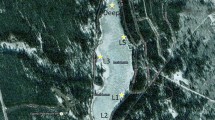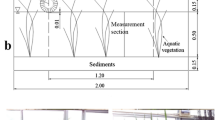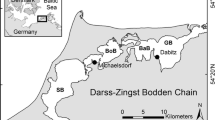Abstract
Eutrophication is common in shallow lakes in lowland areas. In their natural state, most shallow lakes would have clear water and a thriving aquatic plant community. However, eutrophication often causes turbid water, high algal productivity, and low species diversity and abundance of submerged macrophytes. A key indicator of the ecological state of lake ecosystems is the maximum growing depth (MGD) of aquatic plants. However, few studies have yet quantified the relationship between changes in external phosphorus (P) input to a lake and associated variation in MGD. This study examines the relationship between these variables in Loch Leven, a shallow, eutrophic loch in Scotland, UK. A baseline MGD value from 1905 and a series of more recent MGD values collected between 1972 and 2006 are compared with estimated P loads over a period of eutrophication and recovery. The results suggest a close relationship between changes in MGD of macrophytes and changes in the external P load to the loch. Variation in MGD reflected the ‘light history’ that submerged macrophytes had been exposed to over the 5-year period prior to sampling, rather than responding to short term, within year, variations in water clarity. This suggests that changes in macrophyte MGD may be a good indicator of overall, long term, changes in water quality that occur during the eutrophication and restoration of shallow lakes.






Similar content being viewed by others
References
Anderson, N. J., E. Jeppesen & M. Søndergard, 2005. Ecological effects of reduced nutrient loading (oligotrophication) on lakes: an introduction. Freshwater Biology 50: 1589–1593.
Bailey-Watts, A. E., 1979. The Monitoring of Loch Leven Macrophytes. Final Report to the Nature Conservancy Council. Contract no. F3/03/73: 15 pp, 4 Tables, 8 Figures.
Bailey-Watts, A. E. & A. Kirika, 1987. A re-assessment of the phosphorus inputs to Loch Leven (Kinross, Scotland): rationale and an overview of results on instantaneous loadings with special reference to runoff. Transactions of the Royal Society of Edinburgh, Earth Sciences 78: 351–367.
Bailey-Watts, A. E. & A. Kirika, 1999. Poor water quality in Loch Leven (Scotland) in 1995, in spite of reduced phosphorus loadings since 1985: the influences of catchment management and inter-annual weather variation. Hydrobiologia 403: 135–151.
Barker, T., K. Hatton, M. O’Connor & B. Moss, 2008. Effects of nitrate load on submerged plant biomass and species richness: results of a mesocosm experiment. Fundamental and Applied Limnology/Archive für Hydrobiologie 173: 89–100.
Bennion, H., J. Fluin & G. L. Simpson, 2004. Assessing eutrophication and reference conditions for Scottish freshwater lochs using subfossil diatoms. Journal of Applied Ecology 41: 124–138.
Britton, R. H., 1975. Survey of Aquatic Macrophytes in Loch Leven, August 1975. Loch Leven Research Group Annual Report, 1975: 18–26.
Caines, L. A. & R. Harriman, 1976. Chemical Investigations. Loch Leven Research Group Annual Report, 1976: 1–2.
Canfield, D. E. Jr., K. A. Langeland, S. B. Linda & W. T. Haller, 1985. Relations between water transparency and maximum depth of macrophyte colonization in lakes. Journal of Aquatic Plant Management 23: 25–28.
Castle, K., C. A. Frost & D. Flint, 1999. The Loch Leven project – buffer strips in practice on a catchment scale. Aspects of Applied Biology 54: 71–78.
Chambers, P. A. & J. Kalff, 1984. Depth distribution and biomass of submersed aquatic macrophyte communities in relation to Secchi depth. Canadian Journal of Fisheries and Aquatic Science 42: 701–709.
Dale, H. M., 1986. Temperature and light: the determining factors in maximum depth distribution of aquatic macrophytes in Ontario, Canada. Hydrobiologia 133: 73–77.
Dillon, P. J. & F. H. Rigler, 1974. A test of a simple nutrient budget model predicting phosphorus concentration in lake water. Journal of the Fisheries Research Board of Canada 31: 1771–1778.
Drikas, M., C. W. K. Chow, J. House & M. D. Burch, 2001. Using coagulation, flocculation, and settling to remove toxic cyanobacteria. Journal of the American Water Works Association 93: 100–111.
Dudley, B., I. D. M. Gunn, L. Carvalho, I. Proctor, M. T. O’Hare, K. J. Murphy & A. Milligan, submitted. Changes in aquatic macrophyte communities in Loch Leven – evidence of recovery from eutrophication? Hydrobiologia.
Egertson, C. J., J. A. Kopaska & J. A. Downing, 2004. A century of change in macrophyte abundance and composition in response to agricultural eutrophication. Hydrobiologia 524: 145–156.
Elser, J. J., M. E. S. Bracken, E. E. Cleland, D. S. Gruner, W. S. Harpole, H. Hillebrand, J. T. Ngai, E. W. Seabloom, J. B. Shurin & J. E. Smith, 2007. Global analysis of nitrogen and phosphorus limitation of primary producers in freshwater, marine and terrestrial ecosystems. Ecological Letters 10: 1135–1142.
Frost, A., 1996. Loch Leven and diffuse pollution. In Petchey, A., B. D’Arcy & A. Frost (eds) Diffuse Pollution and Agriculture. Proceedings of a Conference Held in Edinburgh, 12–14 April 1995: 174–182.
Griffin, L. R. & A. L. Milligan, 1999. Submerged Macrophytes of Loch Leven, Kinross. Report to Scottish Natural Heritage. Contract no. BAT/LH07/99/00/75: 40 pp, 2 appendices.
Holden, A. V. & L. A. Caines, 1974. Nutrient chemistry of Loch-Leven, Kinross. Proceedings of the Royal Society of Edinburgh Section (B) 74: 101–121.
James, C., J. Fisher & B. Moss, 2003. Nitrogen driven lakes: the Shropshire and Cheshire Meres? Archive Hydrobiology 158: 249–266.
James, C., J. Fisher, V. Russell, S. Collings & B. Moss, 2005. Nitrate availability and hydrophyte species richness in shallow lakes. Freshwater Biology 50: 1049–1063.
Jeppesen, E., M. Søndergaard, M. Søndergaard & K. Christoffersen (eds), 1998. The structuring role of submerged macrophytes in lakes. Springer, New York.
Jeppesen, E., M. Sondergaard, J. P. Jensen, K. E. Havens, O. Anneville, L. Carvalho, M. F. Coveney, R. Deneke, M. T. Dokulil, R. Foy, D. Gerdeaux, S. E. Hampton, S. Hilt, K. Kangur, J. Kohler, E. H. H. R. Lammens, T. L. Lauridsen, M. Manca, M. R. Miracle, B. Moss, P. Noges, G. Persson, G. Phillips, R. Portielje, S. Romo, C. L. Schelske, D. Straile, I. Tatrai, E. Willen & M. Winder, 2005. Lake responses to reduced nutrient loading – an analysis of contemporary long-term data from 35 case studies. Freshwater Biology 50: 1747–1771.
Jones, J. I., J. O. Young, J. W. Eaton & B. Moss, 2002. The influence of nutrient loading, dissolved inorganic carbon and higher trophic levels on the interactions between submerged plants and periphyton. Journal of Ecology 90: 12–24.
Jupp, B. P. & D. H. N. Spence, 1977a. Limitations on macrophytes in a eutrophic lake, Loch Leven. I. Effects of phytoplankton. Journal of Ecology 65: 175–186.
Jupp, B. P. & D. H. N. Spence, 1977b. Limitations of macrophytes in a eutrophic lake, Loch Leven II. Wave action, sediments and waterfowl grazing. Journal of Ecology 65: 431–446.
Jupp, B. P., D. H. N. Spence & R. H. Britton, 1974. The distribution and production of submerged macrophytes in Loch Leven, Kinross. Proceedings of the Royal Society of Edinburgh (B) 74: 195–208.
LLCMP, 1999. Loch Leven Catchment Management Plan: The Report of the Loch Leven Area Management Advisory Group: 93 pp.
May, L., 1980. Ecology of planktonic rotifers at Loch Leven, Kinross-shire. PhD Thesis, Paisley College of Technology: 180 pp.
May, L., B. M. Spears, B. J. Dudley & T. W. Hatton-Ellis, 2010. The importance of nitrogen limitation in the restoration of Llangorse Lake, Wales, UK. Journal of Environmental Monitoring 12: 338–346.
May, L., L. Defew & H. Bennion, submitted. Historical changes in external phosphorus loads to Loch Leven, 1905 to 2005. Hydrobiologia.
Middleboe, A. L. & S. Markager, 1997. Depth limits and minimum light requirements for freshwater macrophytes. Freshwater Biology 37: 553–568.
Moss, B., T. Barker, D. Stephen, A. E. Williams, D. J. Balayla, M. Beklioglu & L. Carvalho, 2005. Consequences of reduced nutrient loading on a lake system in a lowland catchment: deviations from the norm? Freshwater Biology 50: 1687–1705.
Murphy, K. J. & A. Milligan, 1993. Submerged Macrophytes of Loch Leven, Kinross, August 1993. Report to Scottish Natural Heritage. Contract no. 937/F2A/5.3/224: 27 pp, 4 Figures, 8 Maps, 2 Appendices.
Murray, J. & L. Pullar, 1910. Bathymetrical Survey of the Freshwater Lochs of Scotland. Challenger Office, Edinburgh.
Nichols, S. A. & R. C. Lathrop, 1994. Cultural impacts on macrophytes in the Yahara lakes since the late 1800 s. Aquatic Botany 47: 225–247.
OECD, 1982. Eutrophication of Waters: Monitoring Assessment and Control. OECD, Paris: 154.
Pearsall, W. H., 1920. The aquatic vegetation of English lakes. Journal of Ecology 8: 163–201.
Phillips, G. L., D. Eminson & B. Moss, 1978. A mechanism to account for macrophyte decline in progressively eutrophicated waters. Aquatic Botany 4: 103–126.
Riis, T. & I. Hawes, 2003. Effect of wave exposure on vegetation abundance, richness and depth distribution of shallow water plants in a New Zealand lake. Freshwater Biology 48: 75–87.
Robson, T. O., 1986. Loch Leven Kinross Macrophyte Survey, August 1986. Final Report to the Nature Conservancy Council. Contract no. HF3-03-208(46): 43 pp.
Robson, T. O., 1990. Macrophyte Survey August 1990. Report to Nature Conservancy Council. Contract no. 21.F2B.219.DA01: 40 pp.
Rørslett, B. & S. W. Johansen, 1995. Dynamic response of submerged macrophyte, Isoetes lacustris, to alternating light levels under field conditions. Aquatic Botany 56: 223–224.
Sand-Jensen, K., 1990. Epiphyte shading – its role in resulting depth distribution of submerged aquatic macrophytes. Folia Geobotanica and Phytotaxonomica 25: 315–320.
Sand-Jensen, K., N. L. Pedersen, I. Thorsgaard, B. Moeslund, J. Borum & K. P. Brodersen, 2008. 100 years of vegetation decline and recovery in Lake Fure, Denmark. Journal of Ecology 96: 260–271.
Sargent, R. J. & D. C. Ledger, 1992. Derivation of a 130 year run-off record from sluice records for the Loch Leven catchment, south-east Scotland. Proceedings of the Institution of Civil Engineers Water, Maritime and Energy 96: 71–80.
Sas, H. (ed.), 1989. Lake Restoration by Reduction of Nutrient Loading: Expectations, Experiences Extrapolations. Acad. Verlag. Richarz Gmbh, Berlin, Germany: 497.
Scheffer, M., 1998. Ecology of Shallow Lakes. Kluwer Academic Publishers, Dordrecht.
Schwarz, A. & I. Hawes, 1997. Effects of changing water clarity on characean biomass and species composition in a large oligotrophic lake. Aquatic Botany 56: 169–181.
Skubbina, J. P., T. G. Coon & T. R. Batterson, 1995. Increased abundance and depth of submersed macrophytes in response to decreased turbidity in Saginaw bay, Lake Huron. Journal of Great Lakes Research 21: 476–488.
Søndergaard, M., E. Jeppesen, J. P. Jensen & S. Lildalamsinck, 2005. Water framework directive: ecological classification of Danish lakes. Journal of Applied Ecology 42: 616.
Spears, B. M. & I. D. Jones, 2010. The long-term (1979–2005) effects of the North Atlantic oscillation on wind-induced wave mixing in Loch Leven (Scotland). Hydrobiologia. doi:10.1007/s10750-010-0188-9.
Spears, B. M., I. D. M. Gunn, L. Carvalho, I. J. Winfield, B. Dudley, K. Murphy & L. May, 2009. An evaluation of methods for sampling macrophyte maximum colonisation depth in Loch Leven, Scotland. Aquatic Botany 91: 75–81.
Spence, D. H. N., 1964. The macrophyte vegetation of freshwater lochs, swamps and associated fens. In Burnett, J. H. (ed.), The Vegetation of Scotland. Oliver & Boyd, Edinburgh: 306–425.
Spence, D. H. N., 1982. The zonation of plants in freshwater lakes. Advances in Ecological Research 12: 37–124.
Valley, R. D. & M. T. Drake, 2007. What does resilience of a clear-water state in lakes mean for the spatial heterogeneity of submersed macrophyte biovolume? Aquatic Botany 87: 307–319.
Vant, W. N., R. J. Davies-Colley, J. S. Clayton & B. T. Coffrey, 1986. Macrophyte depth limits in north island New Zealand lakes of differing clarity. Hydrobiologia 137: 55–56.
West, G., 1910. An epitome of a comparative study of the dominant phanerogamic and higher cryptogamic flora of aquatic habitat in several lake areas in Scotland. In Murray, J. & L. Pullar (eds), Bathymetrical Survey of the Freshwater Lochs, Vol. I. Challenger Office, Edinburgh: 156–260.
Acknowledgements
We are grateful to the Loch Leven Trustees for daily outflow records and to Helen Bennion, University College London, for an estimate of the P concentration in Loch Leven in 1905 based on palaeolimnological records. We are particularly indebted to the Montgomery family, the owners of the loch, for their continuing support for, and interest in, our research. This research was funded by Scottish Natural Heritage, the Scottish Environment Protection Agency and the Natural Environment Research Council, UK.
Author information
Authors and Affiliations
Corresponding author
Additional information
Guest editors: M. Meerhoff, M. Beklioglu, R. Burks, F. García-Rodríguez, N. Mazzeo & B. Moss / Structure and Function of World Shallow Lakes: Proceedings from the 6th Shallow Lakes Congress, held in Punta del Este, Uruguay, 23–28 November, 2008
Rights and permissions
About this article
Cite this article
May, L., Carvalho, L. Maximum growing depth of macrophytes in Loch Leven, Scotland, United Kingdom, in relation to historical changes in estimated phosphorus loading. Hydrobiologia 646, 123–131 (2010). https://doi.org/10.1007/s10750-010-0176-0
Published:
Issue Date:
DOI: https://doi.org/10.1007/s10750-010-0176-0




